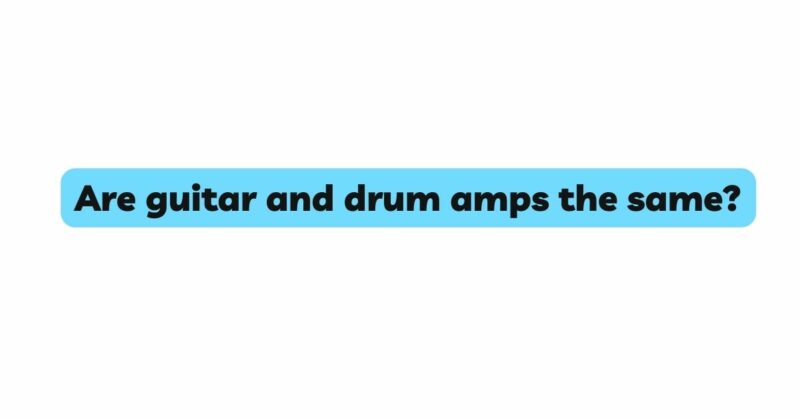In the realm of music, the amplification of instruments plays a pivotal role in shaping the sonic landscape. Instruments like guitars and drums, each with their unique tonal characteristics, require amplification solutions that cater to their specific sonic needs. However, a question often arises: Are guitar and drum amps the same? This article dives deep into the nuances of guitar and drum amplifiers, dissecting their differences, uncovering their similarities, and shedding light on the factors that set them apart in the world of musical amplification.
The Nature of Guitar Amplifiers
To understand the distinctions between guitar and drum amplifiers, it’s crucial to grasp the essence of each type. Guitar amplifiers, commonly referred to as guitar amps, are specially designed to magnify the nuances of electric and acoustic-electric guitars. Electric guitars emit frequencies primarily in the mid-to-high range, emphasizing melodies, harmonies, and chord progressions.
Guitar amps are carefully engineered to accentuate these mid-range frequencies. They come equipped with circuitry, speakers, and components that enhance the tonal qualities of the guitar, often providing options for effects like distortion, reverb, and modulation. Guitar amps are available in various sizes, wattages, and configurations to suit different musical genres, playing styles, and performance environments.
Understanding Drum Amplifiers
Conversely, drum amplifiers, often known as drum monitors or drum amps, serve a distinct purpose in the musical realm. Drum kits comprise an array of percussion instruments, each producing a wide spectrum of frequencies, from the deep resonance of bass drums to the bright shimmer of cymbals. Drum amps are crafted with the intention of accurately projecting the intricate sonic profile of the drum kit.
Drum amplifiers prioritize clarity, definition, and sound dispersion, catering to the needs of drummers who require accurate sound representation during live performances and rehearsals. Unlike guitar amps, drum amps generally do not include built-in effects, as their primary role is to faithfully reproduce the complexity of the drum kit’s sonic makeup.
Frequency Spectrum Differences
One of the most significant factors that differentiate guitar and drum amplifiers is the frequency spectrum they address. Guitar amplifiers emphasize the mid-range frequencies that are synonymous with the expressive qualities of electric guitars. These amps provide a canvas for guitarists to paint their melodies and solos, often covering a frequency range from low mids to upper mids.
In contrast, drum amplifiers must cater to the full frequency spectrum produced by a drum kit. This spectrum extends from the thunderous lows of bass drums to the crisp highs of cymbals. The challenge lies in accurately reproducing this wide range of frequencies, ensuring that the drum kit’s intricate sonic characteristics are captured and projected with fidelity.
Power and Speaker Configuration
Power and speaker configuration are crucial considerations when comparing guitar and drum amplifiers. Drum amplifiers demand a significant amount of power to effectively reproduce the dynamic and diverse sounds of the entire drum kit. The interplay of drum heads, cymbals, and various percussion elements necessitates ample power to ensure clear and precise projection.
Drum amplifiers often employ a combination of full-range speakers and tweeters to accurately reproduce the diverse frequencies of drums and cymbals. This configuration is designed to provide drummers with a comprehensive sonic representation of their instrument, aiding them in maintaining rhythm, timing, and expressive playing.
Tonal Coloration vs. Accuracy
One of the fundamental differences between guitar and drum amplifiers is their approach to tonal coloration. Guitar amps often add tonal enhancements and effects to electric guitars, allowing guitarists to create a signature sound that suits their style. The emphasis on tonal manipulation makes guitar amps a creative tool for shaping the timbre of the instrument.
On the other hand, drum amps prioritize accuracy over tonal coloration. The aim is to faithfully reproduce the intricate timbral qualities of each drum and cymbal, without adding significant coloration or distortion. This accuracy is paramount for drummers who rely on clear and precise sound representation to maintain rhythm and dynamics in live performances.
Conclusion
In conclusion, while both guitar and drum amplifiers fall under the umbrella of musical amplification, they cater to distinctly different musical needs. Guitar amplifiers are tailored to the expressive mid-range frequencies of electric guitars, often offering built-in effects and tonal enhancements that allow guitarists to craft their sonic identity.
Drum amplifiers, on the other hand, are designed to capture and project the wide spectrum of frequencies produced by a drum kit. They prioritize clarity, definition, and accurate sound representation, aiding drummers in maintaining rhythmic precision and expressive playing.
While there may be instances where a guitar amp or drum amp can be repurposed for the other instrument, the ultimate objective is to harness the unique sonic potential of each instrument. By investing in dedicated amplification tailored to the specific needs of guitars or drums, musicians can create an immersive auditory experience that resonates deeply within the musical landscape they contribute to.


